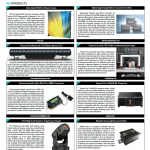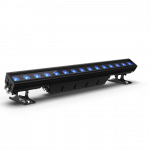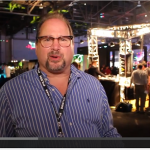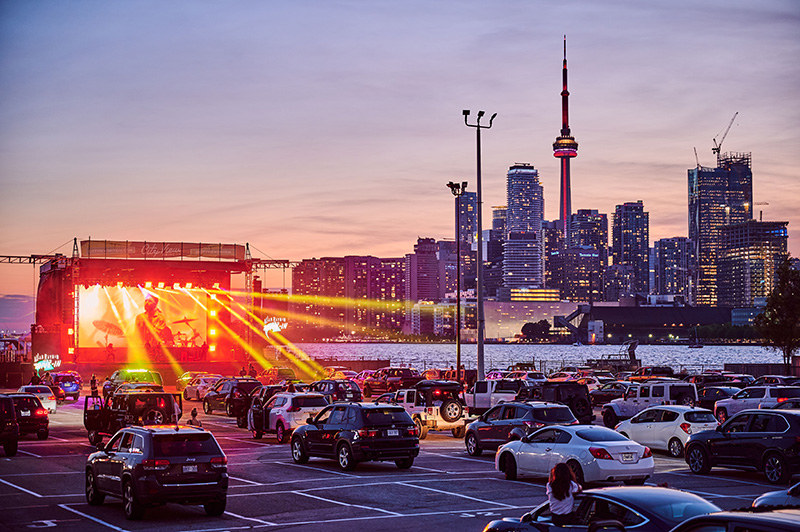
A Massive Portable Stage (and Sturdy Video Wall) Bring Music and Live Events Back to Toronto
Apex Sound & Light’s Doug Cragg will always remember where he was when live music came back to Toronto. The band playing was riff-rock powerhouse Monster Truck. It was July 16, the day after the province of Ontario ended its Covid-19 lockdown. And the venue was Toronto’s brand-new CityView Drive-in, which Cragg and his company helped make possible.
“After the month in lockdown, all the months preceding that in the planning phase — it was definitely a special experience to be there.” Cragg recalls. “There were months of planning, where we weren’t even sure it was going to happen. When we were finally able to do it after getting the go-ahead from the city and the province, hearing that first note of music on the 16th was something special.”
It was also an enormous shift from the direction things had been going. Though Toronto-based Apex Sound & Light has continued more than three decades strong and is normally booked so solid they hire new personnel and add new inventory year-round, Cragg spent the late winter watching a wave of cancellations wipe out the company’s entire summer.
“All the U.S. conferences we had were the first ones to pull out,” Cragg remembers. “That’s when I knew this was going to be a problem.” Soon, of course, the summer’s whole slate of live events was obliterated industry-wide, and live-event professionals searched desperately for a formula that would allow them to continue to function in the absence of everything they had originally planned.
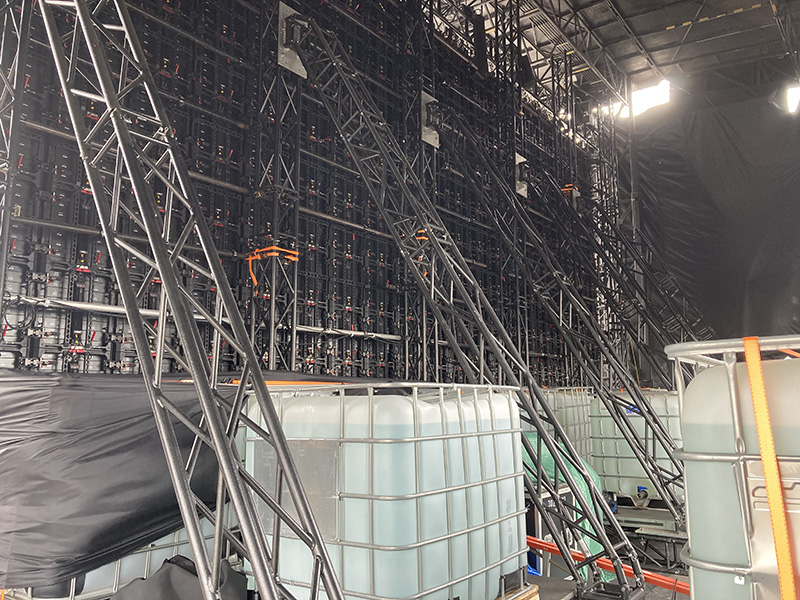
Solid Bookings
In the thick of the pandemic summer, the CityView Drive-in was an extraordinary success. The venue booked, on average, four to five events per week, running to seven-day weeks, such as when CityView became a venue for the Toronto International Film Festival. All through the summer, musical acts like deadmau5, a Tribe Called Red, Dvsn and Allan Rayman played to lots full of fans in their cars — and the venue booked major events all the way to the end of its season, with ‘80s rockers Platinum Blonde booked to play CityView up to the end of the season at Halloween.
As account manager for Apex Sound & Light Corporation, Cragg put months of effort into a plan to bring live music back to a socially distanced society. The Toronto-based company, in its longtime partnership with Toronto hospitality-promotions powerhouse INK Entertainment, spent the spring developing the idea for the CityView Drive-in, a full-time outdoor venue where Toronto residents could enjoy nightly live music and comedy, movies and corporate events from the comfort (and distanced safety) of their cars.
“From the onset, during the lockdown, drive-in events were part of our brainstorm of things we could do,” Cragg recalls. “At that point, we didn’t even know if they’d be allowed. We were months ahead of that ‘okay’ from the government, and as soon as we were able to, we went for it. INK Entertainment was the perfect partner to work with on that. They already had a very robust booking mechanism.”
For Cragg, what made CityView stand apart was the gigantic video wall, installed to span the full 50 feet of a Stageline SAM550 mobile stage. The panels used were ROE Visual MC7, with Brompton Technologies processing, supplied by Apex Sound & Light.
“We were the first to market with a drive-in venue,” he notes, adding that “the new element would be the movie screen. On a Stageline stage, traditionally we do all kinds of different video — funky little strips and things like that. But this was a full video wall that had to be the size of the SAM550. It was an engineering marvel.”
A giant video wall brought CityView a superpower that set it apart from traditional drive-in projections — it offered the ability to display bright, visible video outdoors in the middle of the day.
“There was no other drive-in in the city that had that,” Cragg notes. “From the beginning, it was really about multi-use. With projection, you can’t do [early] evening shows. But we were able to operate whenever, and for corporate events, that was a huge plus — during the day is when those events usually happen.”
Of course, a video wall like no one had ever seen before brought entirely new challenges. The stage was set up on a pier on Toronto’s waterfront, with the vast expanse of Lake Ontario immediately behind it. And along with a Great Lake come great winds.
“That video wall became a sail,” Cragg recalls, “and we needed a support structure that could withstand those types of winds. Half of the stage, the back of it, is all ballast and truss-structures. Normally you put a Stageline in for a weekend, but we put ours in for a season. We spent a great deal of time before the project took off to work with an engineering firm and Stageline’s team to make sure everything would be safe and that giant video wall would be structurally sound.”
This would normally be far too great an expense for a weekend-long festival, Cragg says, but a whole summer-fall season merited the investment. He also notes that, in normal circumstances, they’d never have attempted to mount an entire video wall, but rather many smaller screens.
“Or maybe you’d have a single video wall a third the size of that, but this was a very large video wall for that stage,” says Cragg. “There were a lot of processes to go through to make absolutely sure it would be safe to have a stage that big installed at that location for that long just by the water.”

Concerts, and More
One of the keys to CityView’s success was the venue’s openness to all kinds of events. Unlike many companies in the live-event business, Cragg says his company was able to avert some of the worst impacts of the pandemic because they work across live music, corporate events and film.
“We weren’t just relying on concerts to keep us busy,” he explains. “Part of what we were doing is just keeping people working. It was a factor for sure in our decision making, getting our people back to work. But a greater goal is keeping the industry alive — we don’t want people to forget these things exist. A lot of our motivation was just to keep it going.”
CityView’s willingness to work with trade shows and reimagine those events in a drive-in space helped make certain the venue was booked solid. Cragg argues drive-in conventions really aren’t that different from a trade show where attendees sit at tables or in lines of chairs to listen to speeches from a stage.
“Think of a corporate event simply where you’re sitting in your car rather than sitting at a table,” he says. “The executive teams can present from the stage, they can do PowerPoint presentations, and over FM and the P.A. system, attendees can hear the address clearly. Really, any message they need to deliver, they can do.”
CityView’s Monster Truck show on July 16 was the official start of a whole summer of new approaches to gathering people together. And while drive-in venues are taking off around the world, Cragg is already looking ahead to what the technology augurs for the future.
Few people have worked as closely as Cragg to balance revived live events against public concerns and worries, and Cragg believes the post-pandemic “normal” will come back to the entertainment and events industry bit-by-bit. In order to accommodate members of the public still uneasy about gatherings, Cragg expects there will be an overall rise in event-streaming once the pandemic is through.
“I think what we’re going to see as we begin to come out the other side of the pandemic will be more hybrid events, partially livestreamed and partially in-attendance, based on guidance,” Cragg says. “There’ll still be people who aren’t comfortable, and since we’ve built this streaming infrastructure, there will definitely be some people who’ll prefer to attend from home. So events in the future may carry on that hybrid.”
Related links: www.apexsoundandlight.ca, www.cityviewdrivein.com, www.inkentertainment.com, www.stageline.com
